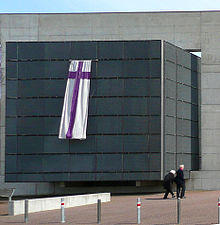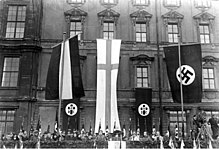Church flag of the Evangelical Church in Germany

The church flag of the Evangelical Church in Germany bears a purple Latin cross on a white background . It is raised as a symbol at major festivals of the Protestant communities at places of worship and community centers. Especially at the Protestant Church Days , it is considered a sign of the presence of Protestant Christianity in society.
history
1919 to 1933

The Protestant church flag owes its existence to the German November Revolution of 1918, the fall of the Wilhelmine Empire and the end of the sovereign church regiment . Until then it was customary to raise the black-white-red flag with the emblem of the Hohenzollern monarchy or the national flag on the church buildings , but with the proclamation of the Weimar Republic on November 9, 1918, a deep uncertainty arose in the church governing bodies. Another low point of the church's perplexity was reached when, with the adoption of the republican imperial constitution in 1919, the colors black, red and gold were elevated to constitutional status. Because the Protestant churches as a whole were unable to recognize these colors, the first flags with the violet cross on a white background were already waving from the steeples of some regional churches in the same month . Attempts by some pastors and parishes to hoist the republican imperial colors on their church in the future failed due to opposition and outrage from conservative church circles. For some, the church flag was an anti-republican emblem , for others like Otto Dibelius it was a skilful church response to the unfortunate flag dispute and at the same time a symbol of the church's independence. Still others, such as Hermann Klugkist Hesse, said the new flag smelled badly of Catholicism .
On December 9, 1926, the German Evangelical Church Committee declared this flag the church flag of the German Evangelical Church Federation . In the following period it was also introduced by all regional churches.
But the flag dispute remained. In 1928 there was an exemplary dispute between the Consistory of the Mark Brandenburg and the Magistrate of Berlin over the flagging of the Propsteig building in the Nikolaiviertel on constitution day , August 11th. The church flagged the building belonging to the city but used by the church only with the church flag and refused to raise the black, red and gold flag of the republic, which led to a lawsuit by the mayor Gustav Boess against the general superintendent and provost of St. Nikolai Wilhelm Haendler led.
1933 to 1945

After the takeover of the Nazis certain Reich President Paul von Hindenburg with a Decree of 12 March 1933 that there should be two national flags in the future: on the one hand the old imperial flag with the black-white-red stripes, plus the swastika flag . Both flags were generally to be hoisted together. Initially, this had no immediate effect on showing the church flag. It could also be shown on public holidays on church buildings and on church events.
On August 9, 1934, however, the national synod of the newly founded German Evangelical Church (DEK) decided unanimously - even with the votes of all representatives of the regional churches of Württemberg and Bavaria, which leaned towards the Confessing Church - to abolish their own church flag in favor of the new state symbol, the swastika flag for the Flagging on national holidays. The church flag was only allowed to continue to be raised on church holidays and occasions.
The actual handling, however, was very different. The Old Prussian Brother Council, the governing body of the Confessing Church for the Church of the Old Prussian Union , reacted to the Flag Act by instructing the communities of the Confessing Church not to reveal the church flag and to use every opportunity to show the cross. There were repeated complaints from party offices about “incorrect” or “insufficient” flagging of churches and church buildings. Individuals, presbyteries and church councils clung to the church flag. After the introduction of the Reichsflaggengesetz (Reichsflaggengesetz) in 1935, which made the swastika flag the only Reich and national flag , state regulations were introduced. A decree of the Reich Ministry of the Interior of October 4, 1935 determined: If public buildings are generally to be flagged, the church buildings and church service buildings are to be flagged with the Reich and national flags alone. If the churches want to flag for another occasion, they can show the church flags. On October 24, 1935, anyone who violated the flag orders was threatened with a fine or imprisonment. The second ordinance for the implementation of the Reichsflaggengesetz banned private persons from showing a church flag - which was primarily directed against the use of Catholic church flags in processions , but also affected the Protestant church flag. In 1936, Reich Church Minister Hanns Kerrl wrote an article on the problem of church flags , in which it becomes clear how much resistance there was still and in which he expressed the expectation that these orders will in future be followed without conflict as something taken for granted .
But since this was not the case, the ordinance of the church chancellery of the DEK on the flagging of church buildings of November 9, 1938 (the day the November pogroms began in 1938 ) finally completely abolished the Protestant church flag and displaying it completely, even on church holidays Prohibited: Insofar as flags are used during church celebrations, only the imperial and national flag may be shown on church buildings and church service buildings.
From 1945

It was not until the liberation from National Socialism in 1945 that the church flag from 1926 became the symbol of the Protestant territorial churches again, which merged into the Evangelical Church in Germany (EKD) that same year . On November 18, 1947, the EKD Council issued a flag ordinance that stipulated that church buildings, if at all, should only be flagged with the church flag: If churches and church buildings are flagged, only the church flag (purple cross on a white background) to be shown. This regulation is still valid today.
The church flag became a widely known symbol of the Evangelical Church in Germany, primarily through public church events such as the German Evangelical Church Days , which can also be seen on local church buildings on the occasion of church festivals such as confirmations or major holidays in the church year .
Today the church flag is regarded as a distinctive figurative mark that could be granted name protection.
Web links
- Blog with an illustration of "Instructions for making a church flag" from the mid-1920s
Individual evidence
- ↑ Hans Prolingheuer: Small political church history. 50 years of Protestant church struggle. Pahl-Rugenstein-Verlag, Cologne 1984, ISBN 3760908705 , p. 31
- ^ Hans Prolingheuer: The case of Karl Barth, 1934-1935: Chronicle of a displacement . Neukirchener Verlag, 2nd edition 1984. ISBN 3-7887-0761-5 , p. 170
- ↑ Hartmut Fritz: Otto Dibelius: a cleric in the time between monarchy and dictatorship. Göttingen: Vandenhoeck & Ruprecht 1998 ISBN 9783525557273 , p. 474
- ^ Subject and milieu in the Nazi state: the diaries of Pastor Hermann Klugkist Hesse. Göttingen: Vandenhoeck & Ruprecht 1994 ISBN 9783525557211 , p. 40
- ^ Kurt Nowak : Evangelical Church and Weimar Republic: on the political path of German Protestantism between 1918 and 1932. 2nd edition, Göttingen: Vandenhoeck & Ruprecht 1988, ISBN 9783525553787 , p. 178
- ↑ Decree of the Reich President on the provisional regulation of the flag raising. (PDF; 93 kB)
- ↑ See the illustration on the title page by Eberhard Röhm, Jörg Thierfelder: Evangelical Church between Cross and Swastika: Pictures and Texts from an Exhibition. Stuttgart: Calwer 1990 ISBN 9783766806888
- ^ Hans Prolingheuer: The case of Karl Barth, 1934-1935: Chronicle of a displacement . Neukirchener Verlag, 2nd edition 1984. ISBN 3-7887-0761-5 , p. 171
- ^ Wilhelm Niemöller: Struggle and witness of the Confessing Church. Bielefeld: Bechauf 1948, p. 156, also in Prolingheuer (1984), p. 172
- ↑ After Young Church 3 (1935), p 991
- ^ First ordinance for the implementation of the Reich Flag Act
- ↑ Second ordinance for the implementation of the Reich Flag Act
- ↑ Quoted from Junge Kirche 4 (1936), p. 1038
- ^ Text based on: Junge Kirche 6 (1938), p. 967
- ↑ VO Church flagging ( Memento from September 11, 2012 in the Internet Archive )
- ↑ Philipp Lehmann: Trademark, trademark and name law in the field of religious communities. Frankfurt a. M .: Peter Lang 2010 (Writings on State Church Law 50) ISBN 9783631600948 , p. 297f
